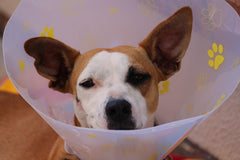
Just about every dog gets a sniffle or sneezes from time to time. As a dog parent, you might worry about this. Sometimes these issues can be random and not mean much at all. However, other times they might indicate an issue with your dog’s snout. This is why as a pet parent, it is your responsibility to know about the signs of good health in dogs. Whether you have a dog with big snout, there is a growth on dog’s snout, or something else is going on with your dog’s snout, it is important to learn more about it. If you are ever concerned about what is happening with your dog, be sure to take them to the veterinarian.
Aspergillosis

Aspergillosis can sound like a funny word, but it is a very real and serious condition. It is caused by fungi that are found in soil and leaf mulch. It can collect inside your dog’s nose. It is important to know that infections, such as this one, are much more common in a dog with a big snout. If your dog has aspergillosis, they might experience facial pain, long-term discharge from their nose, and frequent nosebleeds.
If you suspect that your dog has this condition, be sure to get them to their veterinarian. A blood test can be done to diagnose aspergillosis. It is very important that your dog gets treatment. If it isn’t treated properly or treated at all, your dog’s nose, nasal passageways, and bones inside the nose can be destroyed. Generally, nasal flushes are prescribed for this condition. Taking your dog to the vet regularly is one of the things you can do to boost your dog's life expectancy.
Cancer

Luckily, cancer in the nose is not as common as some other health conditions for dogs. However, it is still diagnosed more than dog owners would like. Generally, it is osteosarcoma or squamous cell carcinoma.
This can affect the bony chambers in your dog’s muzzle. Your dog might experience nosebleeds. They might experience a swollen face, as well. Usually, radiotherapy is used to help treat cancer in a dog. However, your dog might need anesthesia before getting the radiotherapy to keep them still.
Depigmentation

Has your dog’s black leather nose lost its color? Is it now pink? If so, this is known as depigmentation. It is quite common in Rottweilers and other larger breed dogs. This can happen due to various causes such as the following:
- Plastic food bowl allergies - If this is the case, your dog’s immune system will start attacking the pigment cells.
- Uveo-dermatological syndrome - This is usually linked to excessive sun exposure.
- Immune-mediated health conditions - Lupus and pemphigus are the primary conditions under this cause. When these conditions are present, the body starts attacking the cells.
- Vitiligo - The causes of this aren’t known. However, when a dog has this condition, there is something happening to the cells that produce melanin.
- Rare types of cancers
Being able to treat the pigment loss in your dog’s nose, requires diagnosing the condition and making a treatment plan. If you notice that your dog has depigmentation and has any dog sickness warning signs, you should schedule them an appointment with their veterinarian.
Foreign Body

There are many dogs who get a foreign body stuck in their nose. They might sniff it up or a child might put something up the dog’s nose. Either way, this can be very uncomfortable and cause health concerns. If your dog has a big snout, this is much more likely to happen. They could potentially sneeze out the foreign body.
If you notice that your dog is pawing on their nose constantly, sneezing excessively, or having discharge from one of their nostrils, there could be a foreign body lodged into their nose. The veterinarian might need to put a small camera into your dog’s nose to find out if something is lodged up there. If so, they might be able to pull it out carefully or surgery might need to be done to get it out.
Nasal Mites

Your dog might also get nasal mites. This can cause their nasal passageways to become irritated and/or itchy. If you notice that your dog has been scratching at their nose and becoming aggravated, they could have this condition. The treatment will usually consist of anti-parasitic products.
Nosebleeds

There are numerous reasons why your dog might have nosebleeds. They could have damage to the blood vessels in their nose. This could be caused by a foreign body, cancer, or an infection in the nose. Your dog might also have a disorder with the way that their blood clots. In addition, your dog could have gotten into a chemical or poison.
If your dog is getting nosebleeds, it is essential that you have their veterinarian check it out right away. The quicker the cause is determined, the faster treatment can be done.
Crusty Dog Nose

There could be many reasons for your dog’s crusty nose. Some of the most common things that cause this are environmental factors, skin and dog allergies, fungus, sunburn, distemper, and other health conditions. If your dog has a crusty nose that doesn’t go away, you should schedule an appointment with their veterinarian.
Rhinitis

Your dog might have nose inflammation, as well. This is known as rhinitis. If your dog has this condition, you might notice that they sneeze often and have discharge from their nose. Various things can cause this condition such as allergies, infections, and unknown causes. This could be a short or long-term condition.
Conclusion
These are some of the most common issues with a dog’s snout. If your dog is having any nasal or snout issues, be sure to schedule them an appointment with their veterinarian. Tests can be done to determine what is happening with your dog.
What does it mean when a dog’s nose is dry?
Do dogs have snouts or muzzles?
Can dogs get pimples on their snout?
Related Posts:
- The Dog Muzzle
- See These Top 5 Sick Dog Symptoms You Should Know
Dog Whiskers: Everything You Need to Know




